We study detailed mechanisms of chemical reactions in the gas and condensed phases by using laser and molecular beam techniques. In particular, we are interested in identifying primary steps and nascent product state distributions, and understanding reaction mechanisms at the molecular level. Our research is relevant to environmental, atmospheric and combustion chemistry as well as astrochemistry.
Much of our research is concerned with the unimolecular decomposition of free radicals and other transient species. For example, we have studied the photoinitiated decomposition of hydroxyalkyl and chloromethyl radicals. More recently, emphasis has been placed also on the state-specific predissociation of hydrogen-bonded clusters of water with acids and bases such as HCl and ammonia, and with biological molecules. The experimental arrangements include molecular beams, ion and photoelectron imaging, and time-of-flight photofragment spectroscopy. UHV studies of gas-surface and condensed-phase interactions are carried out in collaboration with Professor Curt Wittig. In current experiments, the photoinitiated dynamics in amorphous solid water is studied via nanoimprint lithography. In this novel approach to studying reactions in the condensed phase, pulsed heating of gold nanoparticles is used to initiate reactions in adsorbed layers of ice water doped with organic and inorganic molecules. These processes are relevant to icy bodies in the solar system. Experiments are carried out using laser radiation for heating, and FTIR and time-of-flight mass spectroscopies for product detection. Theoretical modeling is important in all our studies and we have ongoing collaborations with several theoreticians.
Current Projects
-
The name is Bond: Hydrogen Bond
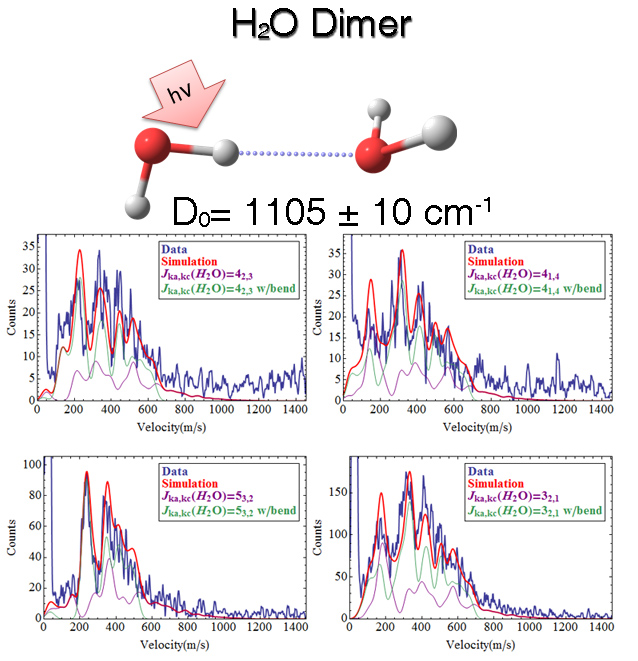


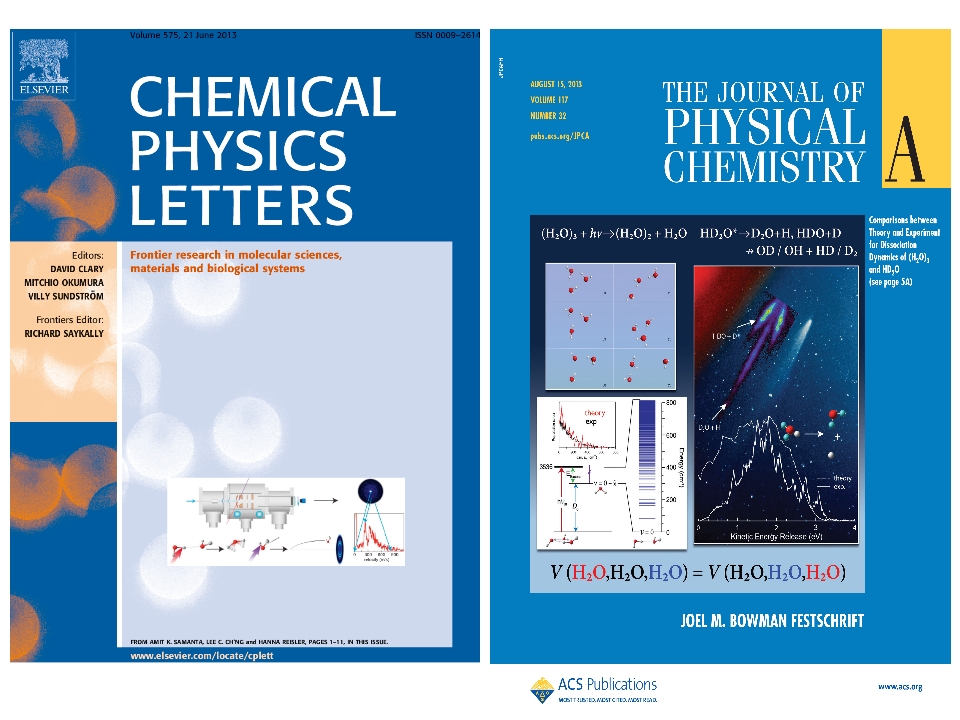
We study state-specific vibrational predissociation dynamics of hydrogen-bonded (H-bonded) dimers and larger clusters of water, acids, and bases. Despite their weak bonding, hydrogen bonds are crucially important in environments ranging from living cells to icy bodies in the solar system. In our studies, the state resolution and detection sensitivity of photofragment ion imaging are exploited to obtain pair-correlated distributions of fragments following laser excitation of a hydrogen-bonded stretch vibration in one of the subunits of the cluster. Encouraged by our success in determining the precise bond dissociation energy of the water dimer, we have extended the work to include cyclic trimers as prototypes of vibrational energy dissipation in larger hydrogen-bonded networks and the effect of cooperativity (non-pairwise interactions). State-specific energy flow patterns that lead to H-bond breaking in dimers and trimers are inferred from quantum state distributions in the fragments,and bond dissociation energies are obtained with spectroscopic accuracy. Vibrational predissociation dynamics and mechanisms are elucidated by comparisons with high-level calculations carried out by the Bowman group at Emory University. A recent success has been the combined experimental and theoretical investigation of the cluster of HCl with three water molecules, the largest cluster in which HCl is not present as solvated fragment ions. Specific systems of current interest include dimers of water with biologically relevant molecules, such as phenol. Learn More...
-
Imaging H2O Photofragments in the Predissociation of the HCl-H2O Hydrogen-Bonded Dimer, B. E. Rocher-Casterline, A. K. Mollner, L. C. Ch'ng, H. Reisler, J. Phys. Chem. A, 115, 6903 (2011).
-
Experimental and Theoretical Investigations of Energy Transfer and Hydrogen-Bond Breaking in the Water Dimer, L. C. Ch'ng, A. K. Samanta, G. Czakó, J. M. Bowman, H. Reisler, J. Am. Chem. Soc., 134, 15430 (2012).
-
Imaging bond breaking and vibrational energy transfer in small water containing clusters, A. K. Samanta, L. C. Ch'ng, H. Reisler, Chem. Phys. Lett., 575, 1 (2013).
-
Experiment and Theory Elucidate the Multichannel Predissociation Dynamics of the HCl Trimer: Breaking Up Is Hard To Do,J. S. Mancini, A. K. Samanta, J. M. Bowman, H. Reisler,DOI:10.1021/jp5015753 (2014), J. Phys. Chem. A
-
Experimental and Theoretical Investigations of Energy Transfer and Hydrogen-Bond Breaking in Small Water and HCl Clusters, A. K. Samanta, G. Czako, Y. Wang, J. S. Mancini, J. M. Bowman, H. Reisler, Acc. Chem. Res., 47, 2700-2709, (2014)
-
Predissociation dynamics of the HCl-(H2O)3 tetramer: An experimental and theoretical investigation, K. Zuraski, Q. Wang, D. Kwasniewski, J. M. Bowman, and H. Reisler, J. Chem. Phys. 148, 204303 (2018)
-
Vibrational predissociation of the phenol-water dimer:A view from the water, D. Kwasniewski, M. Butler, and H. Reisler, Phys. Chem. Chem. Phys.(2019)
-
-
Photodissociation and photoionization of radicals and diradicals
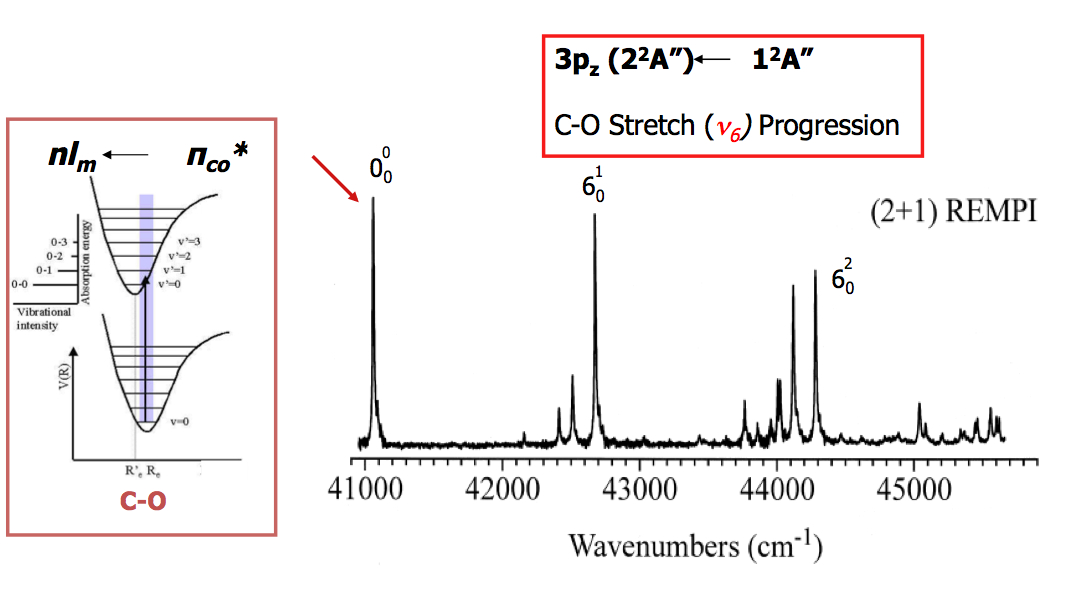
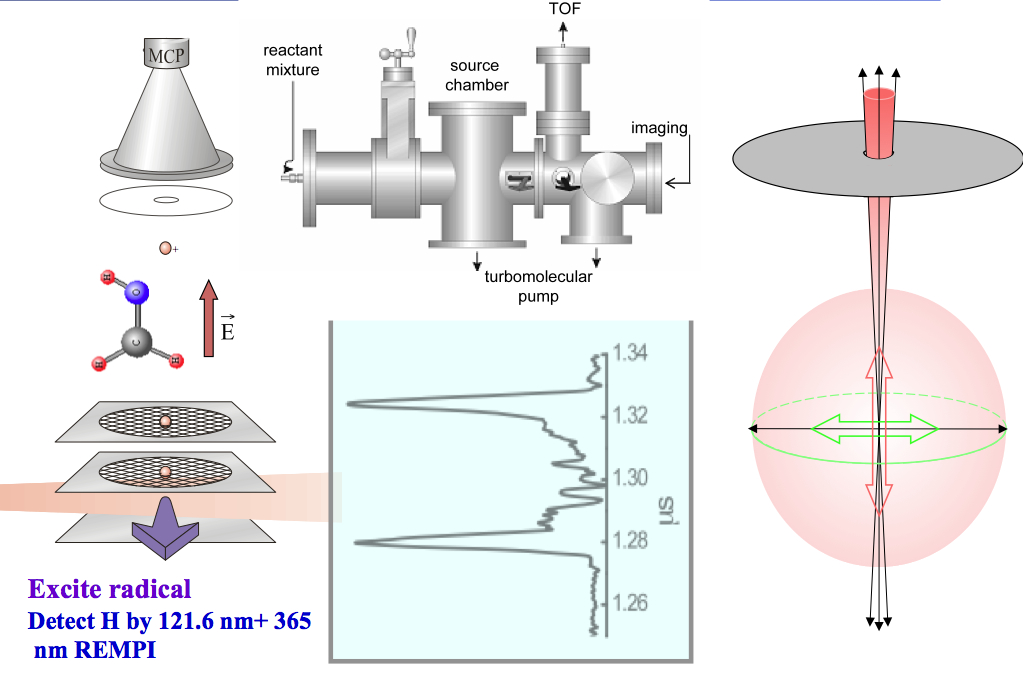
Open shell species such as radicals and diradicals are central to reactive processes in combustion and atmospheric chemistry. Our group is engaged in a long-term program to study several intriguing species, such as hydroxyalkyl radicals and hydroxycarbenes (the tautomers of aldehydes). Our goal is to investigate dissociation and ionization processes of excited molecules and transient species, in which multiple dissociation pathways, including molecular rearrangements, compete. These studies offer opportunities to address fundamental questions related to their open shell nature and the multitude of nonadiabatic interactions and product channels that characterize these systems. The study of open-shell and diradical species poses challenges for both experiment and theory; however, when sophisticated theoretical models are combined with state-of-the-art experimental methods, the evolution from excited state to final products can be followed, including couplings among electronic states and energy disposal in products. Current projects include the photodissociation and tautomerization of alpha-keto carboxylic acids, such as pyruvic acid, and the production, excitation and ionization of hydroxycarbenes.
We use a variety of laser-based spectroscopic techniques to probe reactants and products and time-of-flight and imaging techniques to elucidate the dynamics. A new addition to our "radical machine" is velocity map slice imaging with a novel design that allows us to "slice" images of light particles such as hydrogen with good resolution. We use both photoelectron and photoion imaging, and the BASEX image reconstruction method that we developed is now the most widely used worldwide in reconstructing photoelectron images. Learn More...-
Electronic spectroscopy and photodissociation dynamics of the 1-hydroxyethyl radical CH3CHOH, B. Karpichev, L.W. Edwards, J. Wei and H. Reisler, J. Phys. Chem. A, 112: 412-418 (2008).
-
Interacting Rydberg and valence states in radicals and molecules: Experimental and theoretical studies, H. Reisler and A.I. Krylov, Int. Rev. Phys. Chem., 28(2) 267-308 (2009).
-
Overtone-induced dissociation and isomerization dynamics of the hydroxymethyl radical (CH2OH and CD2OH). I. A theoretical study, E. Kamarchik, C. Rodrigo, J. M. Bowman, H. Reisler, A. I. Krylov, J. Chem. Phys., 136, 084304 (2012).
-
Overtone-induced dissociation and isomerization dynamics of the hydroxymethyl radical (CH2OH and CD2OH). II. Velocity map imaging studies, M. Ryazanov, C. Rodrigo, H. Reisler, J. Chem. Phys., 136, 084305 (2012).
-
Accessing Multiple Conical Intersections in the 3s and 3px Photodissociation of the Hydroxymethyl Radical, C. P. Rodrigo, C. Zhou, H. Reisler,DOI: 10.1021/jp404552g (2013)
-
Imaging Studies of Excited and Dissociative States of Hydroxymethylene Produced in the Photodissociation of the Hydroxymethyl Radical, C. P. Rodrigo, S. Sutradhar, and H. Reisler, DOI:10.1021/jp505108k (2014), J. Phys. Chem. A
-
Temperature dependence of the photodissociation of CO2 from high vibrational levels: 205-230 nm imaging studies of CO(X) and O(3P, 1D) products, S. Sutradhar, B. R. Samanta, A. K. Samanta, and H. Reisler, 147, 013916 (2017)
-
Electronic Structure and Rydberg-Core Interactions in Hydroxycarbene and Methylhydroxycarbene, B. R. Samanta, S. Sutradhar, R. Fernando, A. I. Krylov, and H. Reisler, J. Phys. Chem. A (Jackson Festschrift) 122, 6176-6182 (2018)
-
Spectroscopy and Two-Photon Dissociation of Jet-Cooled Pyruvic Acid, S. Sutradhar, B. R. Samanta, R. Fernando, and H. Reisler, J. Phys. Chem. A (F. Javier Aoiz Festschrift) 123, 5906-5917 (2019)
-
-
Guest-host interactions of molecules in amorphous solid water (ASW)

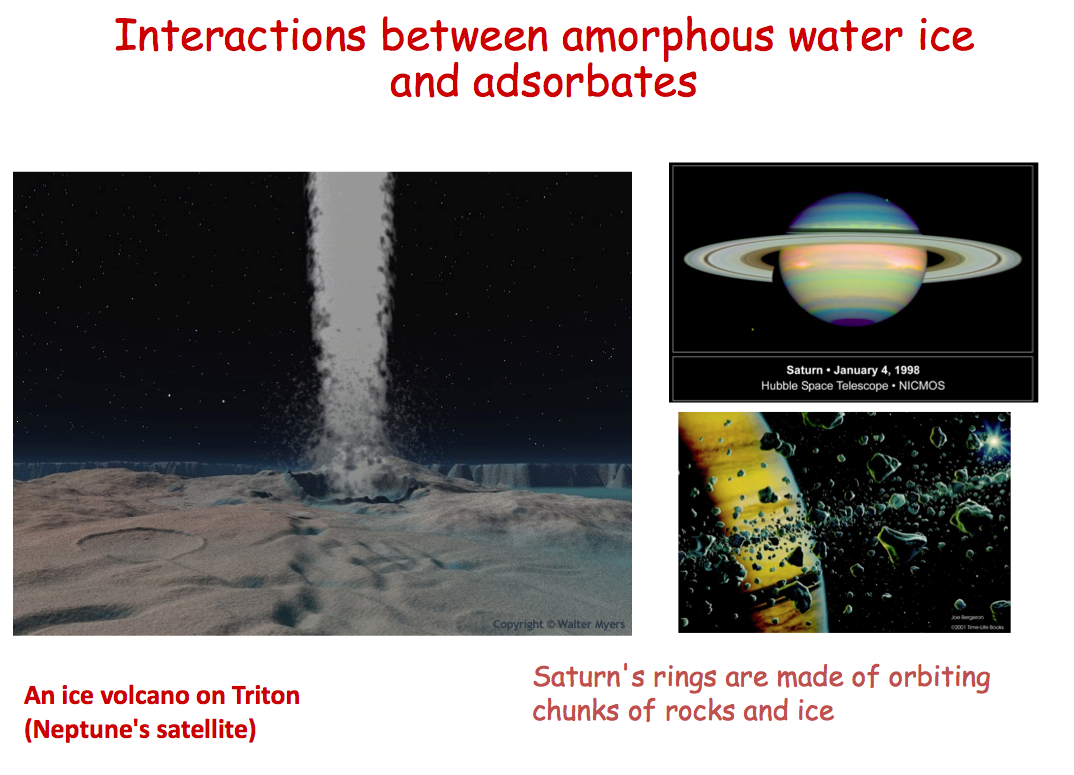
This project is a collaboration with Professor Curt Wittig, and the experiments are preformed under ultrahigh vacuum (UHV) conditions. We confirmed the formation of nitric acid in thin amorphous water films (ASW, ~ 100 K) embedded with N2O4 using proton-induced isotope exchange between H2O and D2O as a probe. We then developed a novel approach for fast heating that obviates the need for N2O4 photoexcitation. An array of gold nanoparticles is prepared using nanolithography. The nanoparticles are heated rapidly using 532 nm radiation to excite the plasmon resonance and transitions originating from the d-bands. The laser pulse excites about a million nanoparticles, each acting as an isolated heat source. Efficient scrambling was observed with even small doses of NO2, in accord with theoretical predictions that the asymmetric dimer ONONO2 in water converts to nitric acid.These experiments are
continuing, and simulations of processes taking place upon heating are in progres. Learn More...-
Amorphous Solid Water Films: Transport and Guest-Host Interactions with CO2 and N2O Dopants, G. Kumi, S. Malyk, S. Hawkins, H. Reisler, and C. Wittig, J. Phys. Chem. A, 110, 2097-2105 (2006).
-
Trapping and release of CO2 guest molecules by amorphous ice, S. Malyk, G. Kumi, H. Reisler, and C. Wittig, J. Phys. Chem. A, 111 (51): 13365-13370 (2007).
-
Amorphous Solid Water (ASW): Pulsed Laser Ablation of ASW/CO2 Thin Films, O. Rebolledo-Mayoral, J. Stomberg, S. McKean, H. Reisler, C. Wittig, J. Phys. Chem. C, 116, 563 (2012).
-
Amorphous Solid Water: Pulsed Heating of Buried N2O4, J. Stomberg, S. McKean, C. Larson, H. Reisler, and C. Wittig,J. Phys. Chem. C, 119, 14548 (2015)
-
Photoinitiated Dynamics in Amorphous Solid Water via Nanoimprint Lithography, C. Larson, Y. Li, W. Wu, H. Reisler, and Curt Wittig, J Phys. Chem. A 121, 4968 (2017)
-

The Reisler Research Group in August 2019

